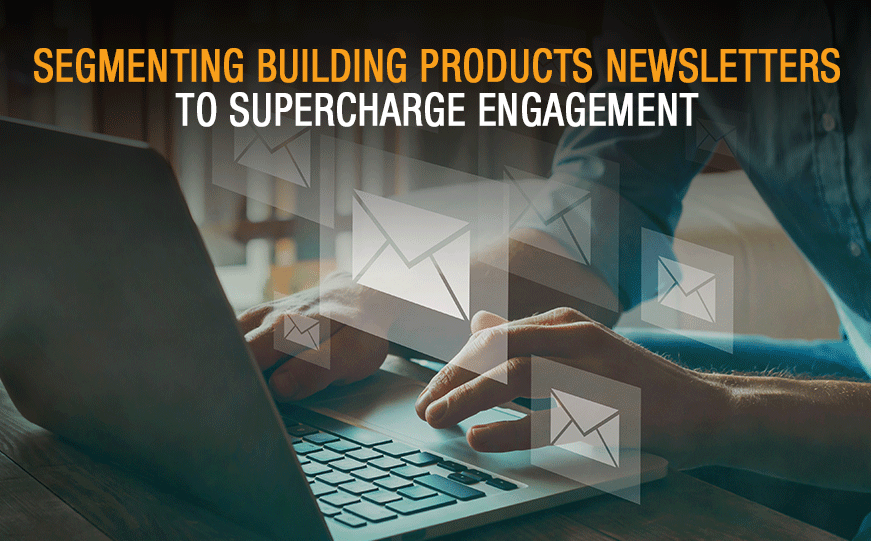In the age of information overload, marketers involved in building material sales face a constant battle for attention.
All too often, one-size-fits-all newsletters end up buried in inboxes… unread and unappreciated. But consider what if that generic content – could be tailored to resonate more deeply – with highly specific audience personas?
Enter the innovative world of segmented newsletters. Where single mailing lists are focused into various specialized sub-lists. And categorized by areas of interest. To result in a true engagement game-changer.
The Power of Personalization
B2B buyers after all – and builder products prospects particularly – are not a monolith. Rather, they each have varying roles. Specialized responsibilities. And truly unique pain points.
A product manager for example, typically craves technical deep dives. While a CFO often seeks ROI-focused case studies.
Segmented newsletters acknowledge these differences… offering content that directly addresses each segment’s needs. It’s a time-tested formula for resonating better with every audience member.
Take a cue from industry leader, HubSpot. Their marketing tools help segment newsletters based on buyer personas. Ensuring that content aligns with recipients’ specific job functions. This targeted approach fosters stronger engagement… as subscribers receive content particularly relevant to their own daily priorities.
Benefits of Segmented Newsletters
- Increased Engagement Subscribers are much more likely – to open and read a newsletter – tailored to their specific interests.
- Improved Lead Nurturing By segmenting based on an audience member’s “buying stage,” it’s possible to deliver targeted content that moves prospects further down the funnel. Early-stage leads can receive more educational content about industry trends. While later-stage leads will celebrate the value of product demos and case studies that showcase successful (and highly relevant) project profiles.
- Enhanced Brand Perception Providing valuable, relevant content demonstrates an understanding of that audience’s needs. This tends to build better trust. And helps to establish more brand loyalty.
- Stronger ROI Targeted newsletters generate a higher return on investment by maximizing the impact of content marketing efforts. Ensuring that marketing budgets are not wasted on irrelevant content that subscribers will ignore.
Segmenting Audiences
There are four “best practice” approaches to segment B2B audiences for newsletters:
- Industry Tailor content to the specific needs of the channels that a brand serves.
- Job Role Focus on the interests relevant to different titles and functions. For example, those issues faced by marketing managers. Or opportunities that support the goals of product development teams.
- Company Size Craft content that addresses the unique challenges faced by a small team. Rather than attempting to tackle macro environments at enterprise level.
- Buying Stage Deliver content appropriate for early-stage awareness – mid-stage consideration – as well as late-stage decision-making phases. And rank each group of prospects by their demonstrated “intent”… to ensure meeting them better at each stage of their journey.
Beyond Segmentation: Best Practices for Captivating Newsletters
Segmentation is merely the initial milestone. To truly supercharge engagement…
- Compelling Headlines Subject lines really matter. Craft headlines that are clear, concise and compel each reader’s interest.
- Visual Appeal Break up text with images, infographics and videos – to improve what our team calls “snack-ability” – and to add visual interest.
- Concise and Actionable Content Busy B2B professionals value brevity. So, get straight to the point. Never fail to offer actionable insights and takeaways.
- Call to Action Tell an audience what to do next. Whether it’s visiting a landing page – downloading a white paper – or requesting a demo. Provide a clear call-to-action… to better guide them toward further engagement.
- Mobile-Friendly Design Ensure each newsletter renders flawlessly on all devices. Especially on mobile phones, where a significant portion of B2B email consumption happens.
- Track and Analyze Use email analytics tools to understand an audience’s response to different content. This information helps to refine an approach. And allows for delivery of even more relevant content… in the future.
Segmentation empowers brand and product managers in building materials marketing to deliver targeted content that resonates deeply with each audience target. Turning “suspects” into “prospects.” Who will sincerely appreciate (even anticipate) captivating newsletters that drive their engagement.
In today’s competitive landscape, B2B buyers crave personalized experiences. Segmentation helps cater to their specific needs. Building trust. And establishing brands… as valuable resources.
It’s no secret that our team members are fans of marketing strategies that prioritize newsletters. Did we pique your interest in this one? If so, let’s develop a plan for delivering a unique brand promise – by leveraging audience segmentation and specialized landing sites – designed to maximize your marketing effectiveness. Send an email to Steve at sk@kleberandassociates.com to get the conversation started.




